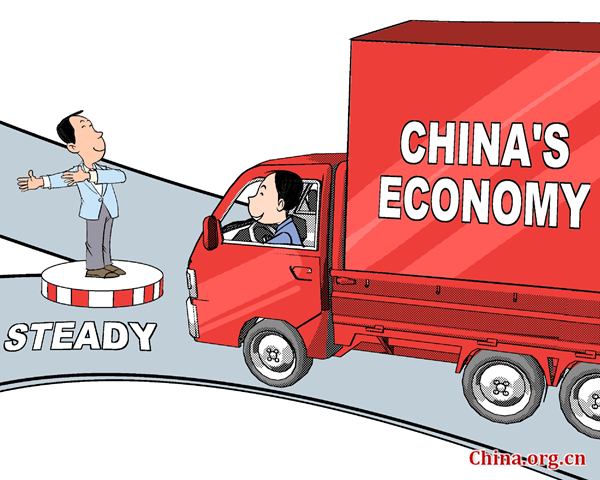Caution needed when analyzing China's economic trajectory
- By Zhang Jingwei
 0 Comment(s)
0 Comment(s) Print
Print E-mail Beijing Review, April 25, 2016
E-mail Beijing Review, April 25, 2016
|
|
|
The right way [By Jiao Haiyang / China.org.cn] |
How can one assess China's economic new normal in the midst of the global economy's mediocre performance? The market is torn on the issue, and the conclusions one might arrive to when considering these factors may clash with other people's perspectives.
Following Moody's revised outlook of China's government credit ratings from stable to negative on March 2, the international ratings agency Standard & Poor's (S&P) also downgraded its credit rating outlook for China on March 31.
That is exactly what some analysts predicted would happen as they believe China is suffering from conflicts between structural reform and stable growth. The world's second largest economy is facing turmoil from the stock and foreign exchange markets, deteriorating local government debt, large numbers of unsold homes, the inflation of consumer prices and the deflation of producer prices as well as falling foreign exchange reserves, validating some analysts' concerns.
Technically, these factors have ended up misleading global rating agencies like Moody's and S&P. This is not because these rating agencies are unprofessional--rather, they are too professional. They've gotten used to assessing the Chinese market through conventional market models and pure mathematical analysis.
The mathematical models used to assess Western economies will not suffice when undergoing an analysis of China's market. The conditions in China are complex: Government and market functions are not completely separate, and the roles of the government and the market in terms of resource allocation are still being straightened out.
Previously, the Western world--including governments, think tanks and international rating agencies--had denied recognizing China's market economy status. This was regardless of the fact that its rapid growth has by and large been prompted by successful market-oriented reforms.
Now, as the Chinese economy enters a phase composed of readjustment and slower growth rates, dubbed as the "new normal," the same Western entities are evaluating China's economy as that of a pure market economy system. Doesn't that analysis conflict with their previous stance on China?
That is the heart of the problem at hand. Actually, before Moody's downgraded China's government credit ratings to negative, China had already demonstrated its determination to stabilize its stock and foreign exchange markets at the G20 Finance Ministers and Central Bank Governors Meeting in Shanghai at the end of February.
After more positive signals were released during this year's full sessions of the National People's Congress and the National Committee of the Chinese People's Political Consultative Conference in March, both markets have returned to a stable state.
In addition, the previously plunging foreign exchange reserves have also improved. Moody's judgment on China therefore seems premature and incorrect. It comes then as no surprise that China's Finance Minister Lou Jiwei said that he doesn't particularly mind Moody's latest ratings at the China Development Forum 2016 in Beijing on March 20.
As major world rating agencies, both Moody's and S&P are using an assessment system based on the market economies in conformity with European and U.S. standards, with each assessment indicator being set within a certain constant. Should the Chinese economy deviate from these standards and constant factors, it would consequently be assessed as being "negative."
The Western world has established a mature and successful market economy model, but that does not mean it should not be closed to other systems. China's market economy system has taken notes from Western market practices and has adapted them to conditions in China, taking advantage of the powerful regulatory role of its government.
Hence it is almost impossible to create an accurate and fair judgment of the Chinese economy through a Western assessment system.
Take monetary policy as an example. Quantitative easing (QE) has proved effective in the United States as a measure to address financial crisis. Japan and the EU are using QE or even more radical measures (such as negative interest rates) as well, to rescue their economies.
In China, however, a variety of policy tools are being employed as the economy shifts gears. After the consumer inflation rate reached 2.3 percent in February, for example, China's central bank stopped lowering the reserve requirement ratio for commercial banks--a move to release liquidity to the market--after a hike on March 1. This demonstrated a flexible and prudent monetary policy.
To evaluate China's economy, one must understand the essence of China's slower growth rate. If one interprets it as the sign of an ailing Chinese economy, or if one just focuses on the government's debt, high leverage ratio and turmoil in the stock, foreign exchange and property markets, one would be ignoring the Chinese Government's efforts to push forward structural reform.
Since 2015, top Chinese leaders and high-ranking officials have repeatedly stated their resolution and confidence in ensuring China's market stability.
An international institution can no doubt make independent assessments on the Chinese market and economy based on their professional standpoint, but they should also listen to voices from within China. Otherwise, obstinate and arbitrary ratings would not only undermine their reputation, but also arouse misunderstandings.
While uncertainties remain in the global market, negative ratings on the world's second largest economy will cause widespread panic. Asia-Pacific stock markets fell when S&P released its negative ratings on China, and the offshore market of the Chinese currency, the renminbi, also fluctuated.
Affected as it is by negative market sentiment, the U.S. Federal Reserve appears unlikely to raise its benchmark interest rates before June. S&P's downgrading of China's government credit ratings to negative will also affect the U.S. and global markets. In fact, S&P has undermined global confidence at a time when the world needed assurance more than anything.
The author is a researcher with the Charhar Institute. The article was originally published in National Business Daily




Go to Forum >>0 Comment(s)